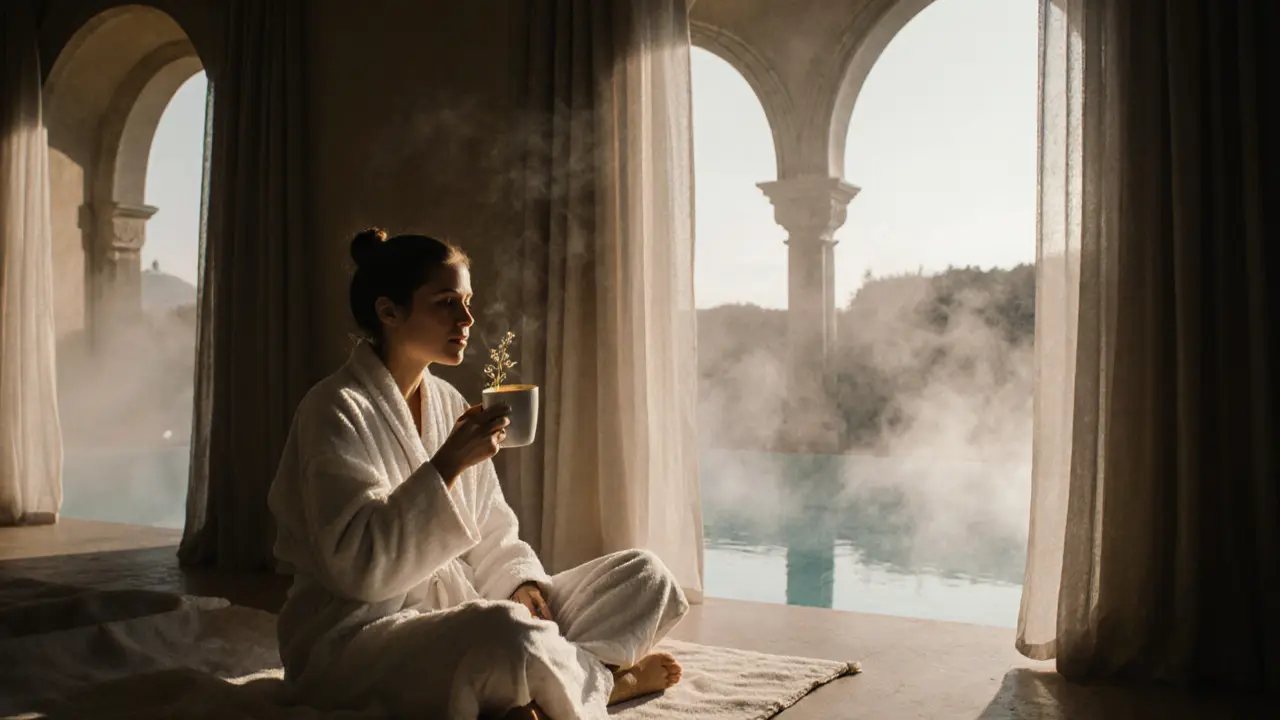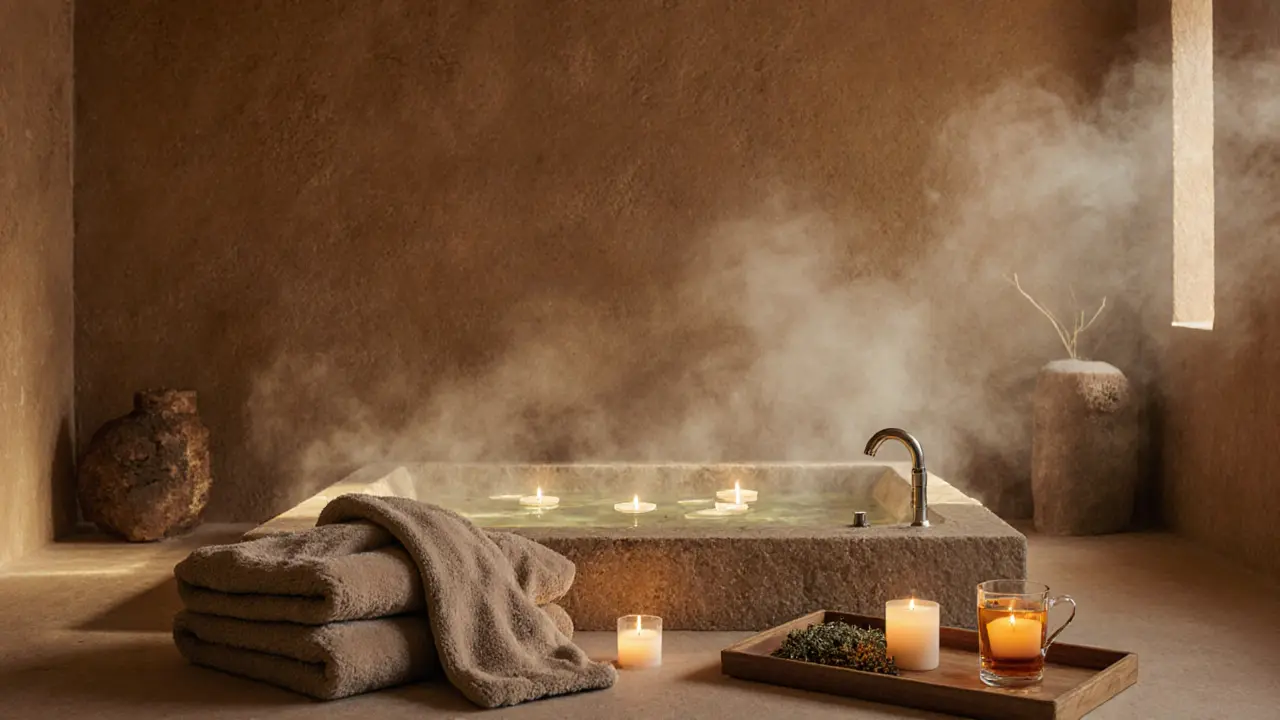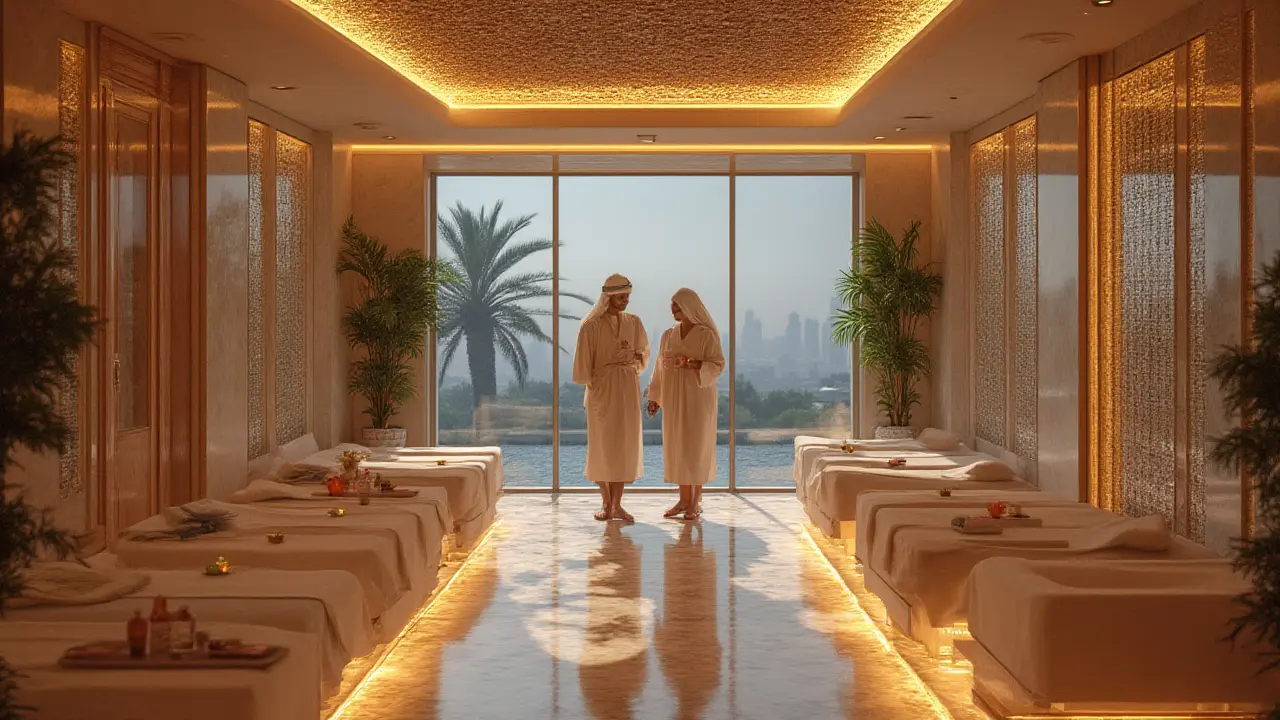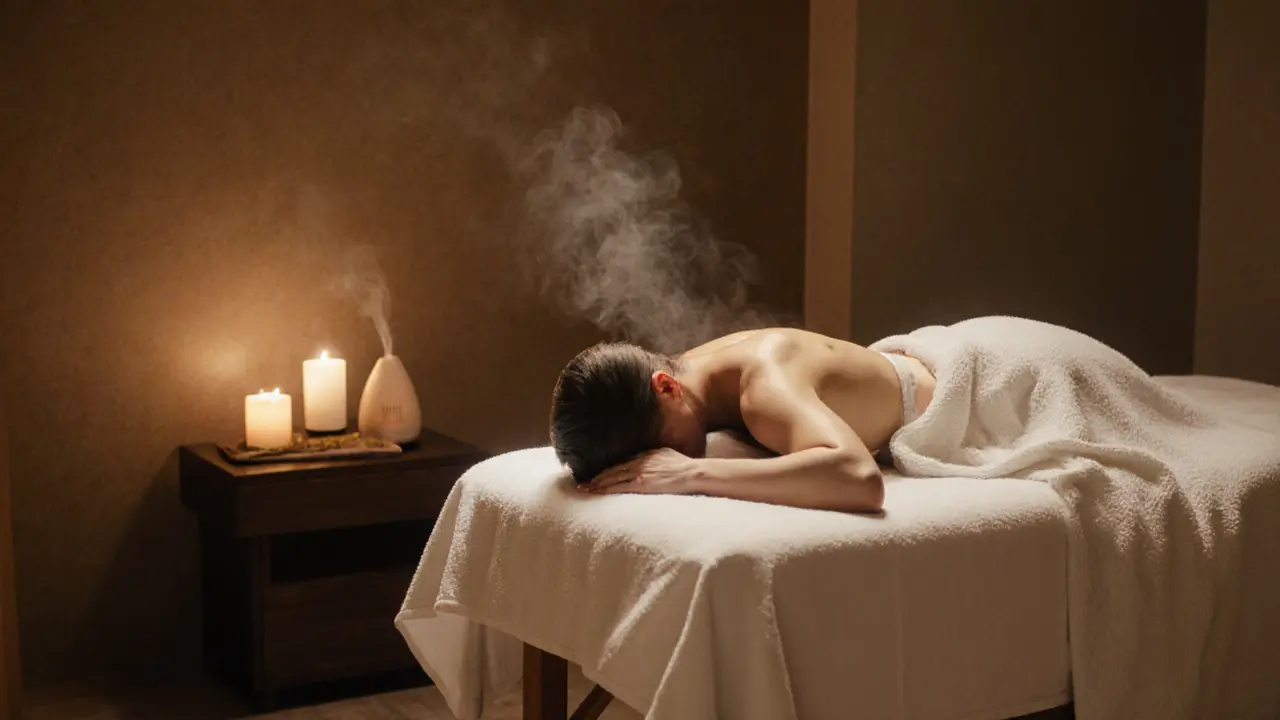When you think of relaxation, the words spa and massage often come up together. But they’re not the same thing - and knowing the difference can help you choose the right experience for your needs. A massage is a single treatment focused on muscles and tension. A spa is a full experience - a destination that might include a massage, but also steam rooms, hot tubs, facials, body scrubs, and quiet spaces to unwind. If you’re looking to reset your mind and body, understanding this distinction matters.
Understanding the Basics of Spa and Massage
Origins and History
Spas trace their roots back thousands of years. Ancient Romans built grand bathhouses for socializing and healing. The word "spa" itself comes from the Belgian town of Spa, famous for its mineral springs since Roman times. In contrast, massage therapy has even older roots - found in Chinese, Indian, Egyptian, and Greek texts. The Chinese practiced pressure-point techniques over 5,000 years ago. The Greeks used massage to prepare athletes for competition. While both have ancient origins, they evolved differently: massage became a targeted healing tool, while spas became holistic retreats.Core Principles or Components
A massage is built around manual manipulation of soft tissues - muscles, tendons, ligaments. The goal? To release tension, improve circulation, and reduce pain. Techniques vary: Swedish for relaxation, deep tissue for chronic tightness, sports massage for athletes. A spa, on the other hand, is a curated environment designed for sensory calm. It includes multiple elements: aromatherapy, temperature therapy (hot tubs, steam rooms), skincare treatments, and often quiet lounges with herbal teas. The core principle of a spa isn’t just physical relief - it’s mental restoration. You’re not just getting your back worked on; you’re stepping into a space designed to disconnect you from stress.How It Differs from Related Practices
Here’s a simple breakdown:| Aspect | Massage | Spa |
|---|---|---|
| Primary Focus | Muscle relief and physical tension | Full-body and mind relaxation |
| Duration | 30 to 90 minutes | 2 to 6 hours |
| Components | One treatment only | Multiple treatments + ambiance |
| Setting | Clinic, studio, or home | Resort, luxury center, or dedicated spa facility |
| Outcome | Reduced soreness, improved mobility | Deep calm, mental reset, sensory renewal |
Who Can Benefit from Spa and Massage?
Anyone with muscle tension, stress, or physical discomfort can benefit from a massage. Athletes, desk workers, and people recovering from injury often use it as a recovery tool. A spa, however, is ideal for those seeking a mental escape. If you’ve been running nonstop for weeks - juggling work, family, and responsibilities - a spa day gives you space to breathe. In Dubai, where life moves fast, many professionals book spa days not because they’re in pain, but because they’re burned out. Spas offer a cultural reset. Massage fixes your body. A spa fixes your mood.Benefits of Spa and Massage for Body and Mind
Stress Reduction
Both reduce stress, but in different ways. A massage lowers cortisol levels - the hormone tied to stress - by stimulating the parasympathetic nervous system. Studies show even a 10-minute massage can reduce heart rate and blood pressure. A spa takes this further. The combination of warm water, quiet lighting, soothing scents, and silence creates what researchers call a "sensory sanctuary." It’s not just about what’s happening to your muscles - it’s about what’s happening to your brain. You’re not just relaxing; you’re retraining your mind to slow down. In Dubai’s high-pressure environment, this mental reset is often more valuable than the physical relief.Enhanced Functionality
Massage directly improves mobility. If you’ve got tight shoulders from typing all day, a deep tissue session can restore range of motion. For athletes, regular massage prevents injury by keeping muscles flexible. A spa doesn’t focus on mobility - but it supports it indirectly. By reducing overall tension and inflammation, spa treatments help your body recover faster. Many people notice they sleep better after a spa day, which means their muscles repair more effectively overnight. It’s a chain reaction: calm mind → better sleep → faster recovery → better movement.Emotional Well-Being
Massage releases endorphins - your body’s natural feel-good chemicals. But spa experiences tap into something deeper: ritual. Lighting candles, soaking in warm water, sipping chamomile tea - these acts signal to your brain that it’s safe to let go. In cultures like Japan and Scandinavia, bathing rituals are tied to mindfulness. Spas in Dubai have adopted this idea. You’re not just getting pampered; you’re participating in a quiet act of self-care. Many clients report feeling more centered, less reactive, and more patient after a full spa day - not because of one treatment, but because of the entire rhythm of the experience.Practical Applications
Think of massage as your weekly tune-up. If you’re active or have a physically demanding job, schedule one every two weeks. A spa, however, is a monthly or quarterly investment. In Dubai’s heat and pace, many people treat it like a mental health check-in - similar to seeing a therapist, but with steam and oils. It’s not a luxury; it’s a maintenance tool. Busy parents, entrepreneurs, and healthcare workers often say their spa days are the only time they truly disconnect. That’s not indulgence - that’s sustainability.| Benefit | Description | Impact |
|---|---|---|
| Physical Relief | Reduces muscle knots and stiffness | Improved movement, less pain |
| Mental Calm | Slows racing thoughts, reduces anxiety | Better focus, emotional balance |
| Sensory Reset | Engages sight, smell, touch in soothing ways | Breaks stress cycles |
| Recovery Boost | Enhances circulation and sleep quality | Faster healing, more energy |
What to Expect When Engaging with Spa and Massage
Setting or Context
A massage usually happens in a quiet, dim room with a massage table. You’ll be draped in towels, and the therapist will work in silence or with soft music. A spa is an entire journey. You might start in a changing room with robes and slippers, then move to a steam room, a relaxation lounge with herbal tea, then a treatment room, and finally a quiet zone to sip water and reflect. In Dubai, top spas include water features, private cabanas, and even sand baths - blending local traditions with global wellness trends.Key Processes or Steps
For a massage: consultation → positioning → technique application → gentle cool-down. For a spa: arrival → robe change → thermal circuit (steam, sauna, cold plunge) → treatment → relaxation → refreshments. The spa process is longer, more ritualistic. It’s not just about what’s done to you - it’s about what you’re allowed to let go of.Customization Options
Massage can be customized by pressure (light, medium, deep), oil type (lavender, eucalyptus), or focus area (neck, back, feet). Spas offer even more: add a body wrap, upgrade to a gold facial, include a scalp massage, or extend your thermal circuit. In Dubai, many spas tailor experiences to local needs - like cooling treatments during summer or hydrating rituals for dry desert air.Communication and Preparation
Before a massage, tell your therapist about injuries, pain points, or preferences. For a spa, communicate your goals: "I need to unwind," or "I have sensitive skin." Most spas will adjust temperature, pressure, or products accordingly. Arrive early. Don’t rush. Spas aren’t meant to be rushed - they’re meant to be felt.
How to Practice or Apply Spa and Massage
Setting Up for Success
For massage at home: use a foam roller or tennis ball for self-myofascial release. For spa-like moments: dim lights, light a candle, play nature sounds, and soak in a warm bath with Epsom salts. You don’t need a luxury center to create calm - just intention.Choosing the Right Tools/Resources
For massage, look for licensed therapists - check credentials through professional bodies like the International Massage Association. For spas in Dubai, read reviews on platforms like Google or Tripadvisor. Look for places with clean facilities, trained staff, and clear hygiene policies. Avoid places that don’t list therapist qualifications.Step-by-Step Guide
Want to try a spa day? Here’s how:- Book a package that includes at least one treatment (massage, scrub, or facial).
- Arrive 30 minutes early to use the thermal areas.
- Hydrate before and after - your body needs water to flush out toxins.
- Turn off your phone. No emails. No calls.
- After your treatment, sit quietly for 10-15 minutes. Don’t jump into your car and rush off.
Tips for Beginners or Couples
First-timers often feel awkward. That’s normal. Most therapists are trained to make you feel safe. If you’re going with a partner, choose a couple’s suite - it’s a great way to bond. But don’t feel pressured to talk. Silence is part of the experience.Safety and Ethical Considerations
Choosing Qualified Practitioners/Resources
Always verify credentials. In Dubai, licensed spas must follow regulations set by the Dubai Health Authority. Ask to see the therapist’s certification. Don’t be afraid to ask: "What’s your training background?" A good professional will be happy to explain.Safety Practices
| Practice | Purpose | Example |
|---|---|---|
| Hydration | Helps flush toxins released during treatments | Drink water before and after |
| Hygiene | Prevents infection | Towels and linens changed between guests |
| Consent | Respects personal boundaries | Therapist asks before adjusting pressure |
Setting Boundaries
You have the right to say "no" to any part of a treatment. If the pressure is too hard, if the room is too hot, if you don’t want to be touched - speak up. A good spa will never make you feel guilty for setting limits.Contraindications or Risks
Avoid massage if you have open wounds, blood clots, or are in early pregnancy without clearance from your doctor. Avoid hot tubs or steam rooms if you have heart conditions or high blood pressure. Always disclose medical conditions before any treatment.Enhancing Your Experience with Spa and Massage
Adding Complementary Practices
Pair your massage with deep breathing. After a spa day, try journaling for 5 minutes. Write down how you felt before and after. This builds awareness and helps you recognize when you need another reset.Collaborative or Solo Engagement
Spa days are powerful alone - it’s your time to reconnect with yourself. But sharing one with a partner or friend can deepen connection. Just make sure you both agree on the pace. Some people want silence. Others want to chat. Communicate ahead of time.Using Tools or Props
At home: use a foam roller, heating pad, or essential oil diffuser. At the spa: ask for heated stones, warm towels, or aromatherapy blends. These small additions make a big difference.Regular Engagement for Benefits
One massage won’t fix chronic pain. One spa day won’t erase a year of stress. But a monthly massage and a quarterly spa day? That’s a sustainable rhythm. Think of it like brushing your teeth - small, regular care prevents bigger problems later.
Finding Resources or Experts for Spa and Massage
Researching Qualified Practitioners/Resources
In Dubai, check the Dubai Health Authority’s website for licensed wellness centers. Read reviews on Google and Trustpilot. Look for consistency in feedback - not just "great massage," but "clean facility," "professional staff," "no pressure to buy packages."Online Guides and Communities
Follow wellness blogs focused on Middle Eastern spa culture. Join Facebook groups like "Dubai Wellness Enthusiasts" for honest reviews and tips. Avoid influencers selling miracle cures - stick to sources that talk about balance, not quick fixes.Legal or Cultural Considerations
Dubai has strict rules about spa operations. Mixed-gender areas must be private. Modesty is respected - robes and towels are always provided. Many spas offer women-only hours. Respect these norms - they’re part of the culture.Resources for Continued Learning
Books like "The Art of Massage" by Dr. George J. B. S. and "Spa Therapy: A Complete Guide" offer solid overviews. YouTube channels like "The Spa Experience" show real treatments without hype.FAQ: Common Questions About Spa and Massage
What’s the main difference between a spa and a massage?
A massage is a single treatment focused on your muscles - it’s about releasing tension and improving movement. A spa is a full experience that might include a massage, but also steam rooms, hot tubs, facials, and quiet relaxation time. Think of massage as a tool, and a spa as a destination. One fixes your body. The other restores your mind.
What happens during a typical spa day?
You arrive, change into a robe, and begin with a thermal circuit - maybe a steam room, then a sauna, then a cold plunge. After that, you’ll receive a treatment like a massage or body scrub. Then you’ll relax in a quiet lounge with tea or fruit. The whole process takes 3-6 hours. It’s not about speed - it’s about letting your nervous system unwind slowly.
Is a massage enough, or do I need a full spa day?
If you’re dealing with muscle pain or stiffness, a massage is often enough. But if you’re feeling mentally drained, overwhelmed, or emotionally burnt out, a full spa day offers something deeper. It’s not just physical relief - it’s a chance to pause, breathe, and reset. Many people in Dubai find that a quarterly spa day prevents burnout better than weekly massages alone.
Can I get the same benefits from a home massage as from a spa?
You can get physical benefits from a home massage - especially with a good foam roller or partner. But you won’t get the full sensory reset. A spa is designed to remove you from your environment - no noise, no distractions, no responsibilities. That mental separation is hard to recreate at home. Think of it like going to a quiet forest versus listening to nature sounds on your phone. One is immersive. The other is a reminder.
Are spa treatments worth the cost in Dubai?
If you’re using it as a luxury treat, maybe not. But if you see it as mental healthcare - like therapy or meditation - then yes. In Dubai’s high-stress environment, a spa day can prevent burnout, improve sleep, and reduce anxiety. Many professionals treat it like a non-negotiable part of their routine. It’s not about the price tag - it’s about what you’re buying: your peace of mind.
Conclusion: Why Spa and Massage Are Worth Exploring
A Path to Sustainable Calm
Massage fixes what’s tight. Spa fixes what’s tired. Together, they’re a powerful duo for anyone living a fast-paced life. You don’t need to spend thousands. You just need to make space - for your body, your breath, and your quiet moments.Try It Mindfully
Start small. Book a 60-minute massage. Then, next month, try a 3-hour spa package. Pay attention to how you feel afterward. That’s your signal - not a trend, not a social post - your own body telling you what you need.Share Your Journey
Tried a spa day in Dubai? Share your experience in the comments - what surprised you? What did you wish you’d known beforehand? Follow this blog for more honest, no-fluff guides to wellness in the Middle East. And remember: taking care of yourself isn’t selfish. It’s essential.Some links may be affiliate links, but all recommendations are based on research and quality.
Word count: 1,672
Suggested Images
- A serene spa room in Dubai with soft lighting, a stone bathtub, and candles
- A licensed therapist giving a massage in a quiet treatment room
- Someone relaxing in a spa robe, sipping herbal tea after a treatment
- Comparison photo: one side shows a person on a massage table, the other shows a person soaking in a spa tub surrounded by steam
- A close-up of essential oils and warm towels used in a spa treatment
Suggested Tables
- Spa vs. Massage: Key Differences
- Key Benefits Compared
- Spa Safety Tips




